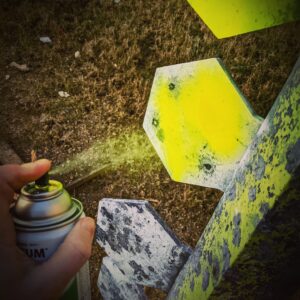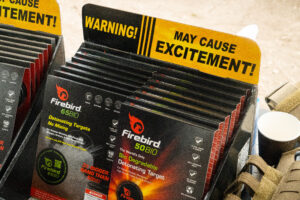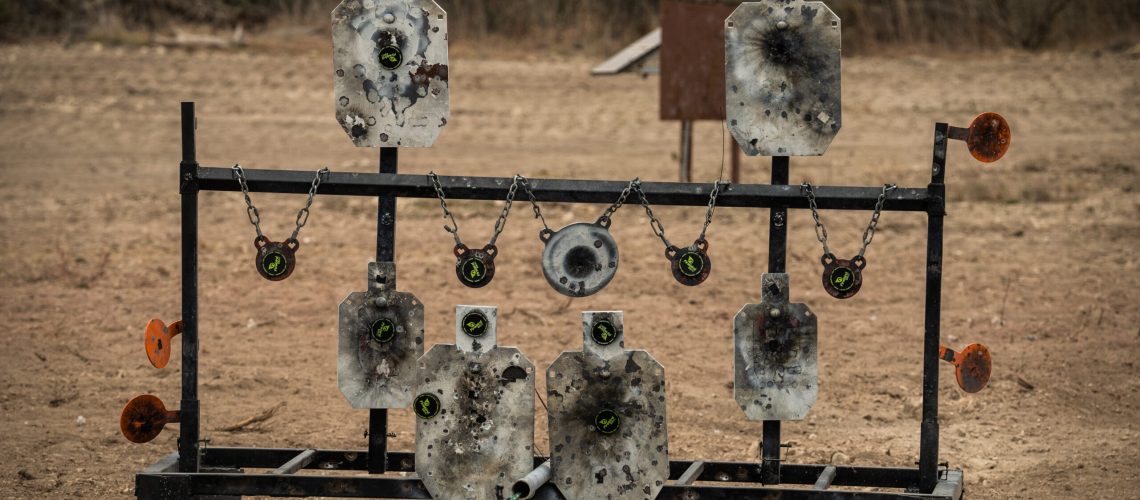Conventional wisdom would advise against shooting at hard targets because they could cause a dangerous ricochet. You certainly wouldn’t want to “shoot your eye out” like Ralphie in A Christmas Story, but when properly used, steel targets offer many benefits over traditional paper targets. Steel targets are made from a hardened steel and are designed to deflect bullets in a safe direction; targets can be either static or reactive.
STEEL TARGET OPTIONS
Static steel targets are often silhouettes of many shapes angled downward at a 15-20 degree angle. This angle ensures the bullets will deflect down and behind the target. Static targets like gongs can be hung by chains, or straps made from rubber or firehose. If you plan on shooting a rifle caliber, use rubber or firehose straps as chains break easily when a missed rifle round strikes them. Because the targets are suspended and free to swing backwards, when a bullet impacts, they automatically provide that 15-20 degree angle. NEVER shoot at a steel target that cannot move and is not angled downwards.
REACTIVE STEEL TARGETS
Reactive steel targets provide more feedback than static targets. Shooting stars are 5 pointed stars with steel targets on each point. When you shoot one point, the steel target falls off which changes the balance of the star. This change of balance causes the star to spin and increases the challenge.

POP UP AND KNOCK DOWN TARGETS
There are also pop up and knock down targets. Pop up targets, like a plate rack, allow a second person to pull chain to make targets appear on command for a shooter knock down. Some knock down targets are spring loaded to pop back up automatically. Dueling trees are another common reactive steel target. A vertical post has targets free to flip 180 degrees side to side horizontally when shot. This can bring some fun competition into practice and allows two shooters to see who can get all the targets to end up on their opponent’s side.
There are also hybrid static and reactive targets like a static silhouette with a 180-degree flipping target over the silhouette’s shoulder. This enables shooters to practice shooting someone using a hostage as a human shield.

BENEFITS OF SHOOTING STEEL TARGETS
The biggest benefit of shooting steel targets is longevity. A paper target lasts as long as you can still see your impacts. A steel target can last for thousands of rounds and easily be re-spraypainted to see new impacts. Depending on the durability of the steel and the bullets you use, you can expect a steel target to last many years. Another great benefit is the instant audible feedback. There are few things in the shooting world as satisfying as hearing a nice ring when you nail a gong target dead center. “Plinking” as it is often called, makes for a more fun shooting experience as you can make all different tones from the impacts on different sized targets. Try shooting a steel target using a suppressed firearm loaded with subsonic rounds, you won’t regret it. This auditory feedback is especially useful when shooting long distance where you would either need a spotting scope or a long walk to check a paper target.
WHEN SHOULD YOU USE STEEL TARGETS AND HOW SHOULD YOU DECIDE?
There are some considerations that need to be made when deciding if you should use steel targets. Obviously, it is primarily dependent on where you are shooting. Public ranges have their own rules around steel targets that you should check before bringing them. If you are shooting on private land, you still must consider safety and the environment. Steel targets MUST be either allowed to move from an impact or be angled 15-20 degrees downward if they are stationary. Dangerous ricochets can occur from improperly mounted steel targets. It is also important to shoot directly in front of the target and not at an angle as this could also cause unpredictable ricochets. You should be at least 10 yards from a steel target when you are shooting. For the longevity of the steel, it is recommended you be 100 yards or more for rifle calibers and 200 yards or more for magnum rifle calibers. Any closer with rifle calibers and you may dent or even penetrate the steel, increasing the chances of unpredictable ricochets. Wearing proper eyewear is also recommended in case bullet jacket fragments backwards, which is not unheard of. The risks of these fragments and ricochets can be mitigated by using special frangible ammunition designed to virtually disintegrate on impact.

Environmentally, many areas prohibit steel targets due to the risk of steel core bullets creating sparks on steel targets which could start forest fires. It is never recommended to shoot steel core bullets at steel targets for this reason and preservation of the target. Due to the steel core, these bullets will penetrate the target enough to cause a dent. Cumulatively, this could make the steel target unsafe to shoot. Incendiary and tracer rounds should be avoided for similar fire hazards.
There are many options available when choosing a steel target. While some people opt to use steel scrap as a target, this is dangerous. Most steel is too mild to be safely shot at and using any steel surface that is not flat, will cause ricochets. NEVER shoot at curved metal targets such as I-beams. Many reputable retailers such as Birchwood Casey (25% off for FLP members) sell steel targets you can trust to be made from the right material and shape.
HOW TO CHOOSE A STEEL TARGET BASED ON YOUR CALIBER.
Steel targets come in many shapes and sizes so there is a great variety to choose from. You will often see targets marked AR400 and AR500. AR400 is for pellet rifles and rimfire calibers only. When choosing an AR500 target for centerfire calibers, it is important to look at the thickness of the target. 1/4in is for pistols except 44 magnum. 3/8in is the most common and will handle up to .308. 1/2in is for more powerful calibers like 6.5 Creedmoor and 12ga slugs. The thickest commonly found steel target is 5/8in which is rated for 50bmg. You can shoot thicker steel with smaller calibers but don’t shoot thinner steel with larger calibers. Even a single 9mm can ruin a rimfire target but a million rounds for 22lr will never dent a 50bmg target.
Steel targets are a fantastic way to enhance your shooting experience. While paper targets may show your grouping better for accuracy’s sake, steel targets can provide that instant feedback of a hit and can last years. Like all aspects of shooting sports, as long as safety precautions are strictly followed steel targets can be the right choice for you.

